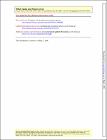| dc.contributor.author | EGANA, MIKEL | |
| dc.date.accessioned | 2009-05-05T18:12:52Z | |
| dc.date.available | 2009-05-05T18:12:52Z | |
| dc.date.issued | 2005 | |
| dc.date.submitted | 2005 | en |
| dc.identifier.citation | Ega?a, M. and Green, S. `Effect of body tilt on calf muscle performance and blood flow in humans? in Journal of Applied Physiology, 98, 2005, pp 2249 - 2258 | en |
| dc.identifier.other | Y | |
| dc.identifier.other | Y | en |
| dc.identifier.uri | http://hdl.handle.net/2262/29608 | |
| dc.description | PUBLISHED | en |
| dc.description.abstract | To explore the effect of posture on muscle performance, we tested the effects of body tilt angle on the strength, endurance, and fatigue of, and blood flow into, the plantar flexors. Human subjects were fixed to a tilt table that could tilt them from the horizontal (0?) to upright (90?) position and enabled force to be applied to a footplate through isometric action of the right calf muscle. In experiment 1, six subjects performed a strength test and graded test (intermittent contractions) to the point of failure at three tilt angles (0, 47, and 90?). In Experiment 2, seven subjects performed a strength test and constant-force test [70% maximum force (Fmax); intermittent contractions] to the point of failure in the horizontal and three inclined positions (32, 47, and 67?). In experiment 3, leg blood flow was assessed during constant-force exercise at two intensities (30 and 70% Fmax) and two tilt angles (0 and 67?) in six subjects. Strength was not affected (P > 0.05) by tilt angle. Time to failure during the graded test was significantly higher at 47? (25.9 ? 2.0 min) and 90? (25.1 ? 3.0 min) than 0? (22.2 ? 2.6 min). Time to failure during the constant-force test was also significantly higher at 32? (7.1 ? 3.6 min), 47? (8.0 ? 5.2 min), and 67? (8.6 ? 5.6 min) compared with 0? (4.0 ? 2.6 min). When graded or constant-force exercise was performed with arterial flow to the leg eliminated, there were no differences in exercise time between the horizontal and an inclined position. During nonischemic exercise, leg blood flow was significantly higher during exercise in the inclined position. These results demonstrate that head-up tilt improves endurance of the plantar flexors, that this effect occurs in the absence of an effect on strength, and that it depends on an intact peripheral circulation. Moreover, the postural effect on muscle endurance appears to be due to a greater blood flow into the leg, an effect that is established during the initial contractions. | en |
| dc.format.extent | 2249 | en |
| dc.format.extent | 2258 | en |
| dc.format.extent | 61570 bytes | |
| dc.format.mimetype | image/jpeg | |
| dc.language.iso | en | en |
| dc.publisher | American Physiological Society | en |
| dc.relation.ispartofseries | Journal of Applied Physiology | en |
| dc.relation.ispartofseries | 98 | en |
| dc.rights | Y | en |
| dc.subject | Physiology | en |
| dc.title | Effect of body tilt on calf muscle performance and blood flow in humans | en |
| dc.type | Journal Article | en |
| dc.type.supercollection | scholarly_publications | en |
| dc.type.supercollection | refereed_publications | en |
| dc.identifier.peoplefinderurl | http://people.tcd.ie/megana | |
| dc.identifier.rssinternalid | 28470 | |
| dc.identifier.rssuri | http://dx.doi.org/10.1152/japplphysiol.01235.2004 | |




